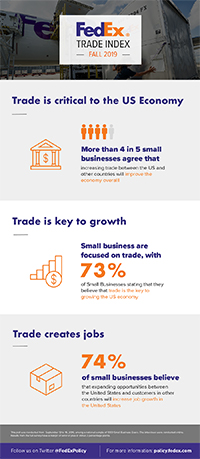82% of small businesses say global trade drives economic growth
Small-business leaders increasingly view U.S. participation in global trade as a way to improve the overall economy and create jobs at home, according to the fifth FedEx Trade Index, released October 24.
The survey of more than 1,000 small-business leaders tracks the effects of international trade on U.S. small businesses, according to FedEx, which conducted the survey in October in partnership with consulting firm Morning Consult.
More than 80% of small-business leaders said that increasing U.S. trade is beneficial to the overall economy, while 75% said that selling goods online to international customers is important to the growth of their business, the survey found. When asked about the effect of tariffs on their business, 80% reported that there has been "some degree of impact," and 74% said that expanding opportunities for international trade will increase job growth in the United States.
Brie Carere, executive vice president and chief marketing and communications officer for FedEx, said the survey results underscore the need to simplify and expand global trade.
"We believe everyone benefits when it's easier to bring new ideas and products to the global market," Carere said in a statement announcing the release of the survey. "Breaking down trade barriers is essential to creating new opportunities for our small business customers."
The survey also revealed strong support for North American free trade agreements. Seventy-nine percent of small-business decision makers surveyed said they supported the North American Free Trade Agreement (NAFTA), and 84% said they support the U.S. Mexico Canada Agreement (USMCA).
Related Articles
Copyright ©2024. All Rights ReservedDesign, CMS, Hosting & Web Development :: ePublishing
